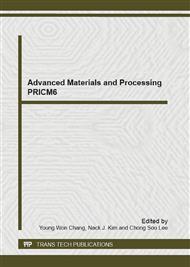p.507
p.511
p.515
p.519
p.523
p.527
p.531
p.535
p.539
Functions and Morphology of Metal Lead Addition to Ancient Chinese Bronzes
Abstract:
The typical morphology of metal lead (Pb) in ancient bronzes made in the Spring-Autumn Warring States Period (770 B.C. –221 B.C.), China, was examined by using electron microscopic techniques. We propose that the main purposes for adding metallic Pb in a large quantity into ancient bronzes such as arrows and ritual vessel-Ding were for increasing weight and economical reasons. SEM observations from the fracture surface of the bronzes revealed that the Pb particle possessed a “hollow–cored bubble” structure, which was formed due to absorbing casting gases during solidification and therefore indirectly eliminated the casting porosity and loosen.
Info:
Periodical:
Pages:
523-526
Citation:
Online since:
October 2007
Authors:
Price:
Сopyright:
© 2007 Trans Tech Publications Ltd. All Rights Reserved
Share:
Citation:


